Investigation of the Constitutive Model of W/PMMA Composite Microcellular Foams
Abstract
1. Introduction
2. Materials and Methods
2.1. Preparation of W/PMMA Composite Microcellular Foams
2.2. Compressive Tests of W/PMMA Composite Microcellular Foams
2.3. Constitutive Models of Foam Material
3. Results
3.1. Characterization of W/PMMA Composite Microcellular Foams
3.2. Mechanical Properties of W/PMMA Composite Microcellular Foams
3.3. Constitutive Model of W/PMMA Composite Microcellular Foams
4. Discussion
4.1. Parameter Identification of W/PMMA Composite Microcellular Foams
4.2. Application and Verification of the Constitutive Model
5. Conclusions
Author Contributions
Funding
Conflicts of Interest
References
- Leng, J.; Xin, L.; Liu, Y.; Du, S. Shape-memory polymers and their composites: Stimulus methods and applications. Prog. Mater. Sci. 2011, 56, 1077–1135. [Google Scholar] [CrossRef]
- Zhao, Q.; Qi, H.J.; Xie, T. Recent Progress in Shape Memory Polymer: New Behavior, Enabling Materials, and Mechanistic Understanding. Prog. Polym. Sci. 2015, 49, 79–120. [Google Scholar] [CrossRef]
- Wu, G.; Chan, K.C.; Zhu, L.; Sun, L.; Lu, J. Dual-phase nanostructuring as a route to high-strength magnesium alloys. Nature 2017, 545, 80–83. [Google Scholar] [CrossRef] [PubMed]
- Jop, P.; Forterre, Y.; Pouliquen, O. A constitutive law for dense granular flows. Nature 2006, 441, 727–730. [Google Scholar] [CrossRef] [PubMed]
- Oyen, M.L. Mechanical characterisation of hydrogel materials. Int. Mater. Rev. 2014, 59, 44–59. [Google Scholar] [CrossRef]
- Cisse, C.; Zaki, W.; Zineb, T.B. A review of constitutive models and modeling techniques for shape memory alloys. Int. J. Plast. 2016, 76, 244–284. [Google Scholar] [CrossRef]
- Steinmetza, D.R.; Wietbrock, B.; Eisenlohr, P.; Gutierrez-Urrutia, I.; Saeed–Akbari, A.; Hickel, T.; Rotersaa, F. Revealing the strain-hardening behavior of twinning-induced plasticity steels: Theory, simulations, experiments. Acta Mater. 2013, 61, 494–510. [Google Scholar] [CrossRef]
- Czlonka, S.; Strakowska, A.; Strzelec, K.; Adamus-Wlodarczyk, A.; Kairyte, A.; Vaitkus, S. Composites of Rigid Polyurethane Foams Reinforced with POSS. Polymers 2019, 11, 336. [Google Scholar] [CrossRef] [PubMed]
- Dattelbaum, D.M.; Coe, J.D. Shock-Driven Decomposition of Polymers and Polymeric Foams. Polymers 2019, 11, 493. [Google Scholar] [CrossRef] [PubMed]
- Fei, Y.; Fang, W.; Zhong, M.; Jin, J.; Fan, P.; Yang, J.; Fei, Z.; Xu, L.; Chen, F. Extrusion Foaming of Lightweight Polystyrene Composite Foams with Controllable Cellular Structure for Sound Absorption Application. Polymers 2019, 11, 106. [Google Scholar] [CrossRef] [PubMed]
- Volpe, V.; Lanzillo, S.; Affinita, G.; Villacci, B.; Macchiarolo, I.; Pantani, R. Lightweight High-Performance Polymer Composite for Automotive Applications. Polymers 2019, 11, 326. [Google Scholar] [CrossRef] [PubMed]
- Wang, L.; Okada, K.; Hikima, Y.; Ohshima, M.; Sekiguchi, T.; Yano, H. Effect of Cellulose Nanofiber (CNF) Surface Treatment on Cellular Structures and Mechanical Properties of Polypropylene/CNF Nanocomposite Foams via Core-Back Foam Injection Molding. Polymers 2019, 11, 249. [Google Scholar] [CrossRef] [PubMed]
- Marsavina, L.; Linul, E.; Voiconi, T.; Sadowski, T. A comparison between dynamic and static fracture toughness of polyurethane foams. Polym. Test. 2013, 32, 673–680. [Google Scholar] [CrossRef]
- Marsavina, L.; Dan, M.C.; Linul, E.; Apostol, D.A.; Voiconi, T.; Sadowski, T. Refinements on fracture toughness of PUR foams. Eng. Fract. Mech. 2014, 129, 54–66. [Google Scholar] [CrossRef]
- Marsavina, L.; Sadowski, T. Dynamic fracture toughness of polyurethane foam. Polym. Test. 2008, 27, 941–944. [Google Scholar] [CrossRef]
- Andersons, J.; Kirpluks, M.; Stiebra, L.; Cabulis, U. Anisotropy of the stiffness and strength of rigid low-density closed-cell polyisocyanurate foams. Mater. Des. 2016, 92, 836–845. [Google Scholar] [CrossRef]
- Andersons, J.; Cābulis, U.; Stiebra, L.; Kirpļuks, M.; Spārniņš, E. Modeling the mode I fracture toughness of anisotropic low-density rigid PUR and PIR foams. Int. J. Fract. 2017, 205, 1–8. [Google Scholar] [CrossRef]
- Lagzdins, A.; Zilaucs, A.; Beverte, I.; Andersons, J. Estimation of the elastic constants of highly porous cellular plastics reinforced with fibres embedded in foam struts. J. Compos. Mater. 2016, 50, 1169–1180. [Google Scholar] [CrossRef]
- Ozturk, U.E.; Anlas, G. Energy absorption calculations in multiple compressive loading of polymeric foams. Mater. Des. 2009, 30, 15–22. [Google Scholar] [CrossRef]
- Koohbor, B.; Kidane, A.; Lu, W.Y. Effect of specimen size, compressibility and inertia on the response of rigid polymer foams subjected to high velocity direct impact loading. Int. J. Impact Eng. 2016, 98, 62–74. [Google Scholar] [CrossRef]
- Xin, Y.; Yong, X.; Zhou, Q. Influence of stress softening on energy-absorption capability of polymeric foams. Mater. Des. 2011, 32, 1167–1176. [Google Scholar]
- Koohbor, B.; Kidane, A. Design optimization of continuously and discretely graded foam materials for efficient energy absorption. Mater. Des. 2016, 102, 151–161. [Google Scholar] [CrossRef]
- Gigliotti, L.; Pinho, S.T. Prediction of the post-crushing compressive response of progressively crushable sandwich foam cores. Compos. Part A Appl. Sci. Manuf. 2016, 80, 148–158. [Google Scholar] [CrossRef]
- Wang, D.A.; Pan, J. A non-quadratic yield function for polymeric foams. Int. J. Plast. 2006, 22, 434–458. [Google Scholar] [CrossRef]
- Rusch, K.C. Load–compression behavior of flexible foams. J. Appl. Polym. Sci. 1969, 13, 2297–2311. [Google Scholar] [CrossRef]
- Gibson, L.J.; Ashby, M.F. Cellular Solids Structures and Properties, 2nd ed.; Cambridge University Press: Cambridge, UK, 1999. [Google Scholar]
- Ashby, M.F.; Bréchet, Y.J.M. Designing hybrid materials. Acta Mater. 2003, 51, 5801–5821. [Google Scholar] [CrossRef]
- Liu, Q.; Subhash, G. A phenomenological constitutive model for foams under large deformations. Polym. Eng. Sci. 2004, 44, 463–473. [Google Scholar] [CrossRef]
- Avalle, M.; Belingardi, G.; Ibba, A. Mechanical models of cellular solids: Parameters identification from experimental tests. Int. J. Impact Eng. 2007, 34, 3–27. [Google Scholar] [CrossRef]
- Goga, V. New Phenomenological Model for Solid Foams. In Computational Modelling and Advanced Simulations; Springer Netherlands: Dordrecht, the Netherlands, 2011; pp. 67–82. [Google Scholar]
- Colton, J.S.; Suh, N.P. Nucleation of microcellular foam: Theory and practice. Polym. Eng. Sci. 2010, 27, 500–503. [Google Scholar] [CrossRef]
- Gong, W.; Fu, H.; Zhang, C.; Ban, D.M.; Yin, X.G.; He, Y.; He, L.; Pei, X.L. Study on Foaming Quality and Impact Property of Foamed Polypropylene Composites. Polymers 2018, 10, 375. [Google Scholar] [CrossRef]
- Chen, L.; Schadler, L.S.; Ozisik, R. An experimental and theoretical investigation of the compressive properties of multi-walled carbon nanotube/poly(methyl methacrylate) nanocomposite foams. Polymer 2011, 52, 2899–2909. [Google Scholar] [CrossRef]
- Saha, M.C.; Mahfuz, H.; Chakravarty, U.K.; Uddin, M.; Kabir, M.E.; Jeelani, S. Effect of density, microstructure, and strain rate on compression behavior of polymeric foams. Mater. Sci. Eng. A 2005, 406, 328–336. [Google Scholar] [CrossRef]
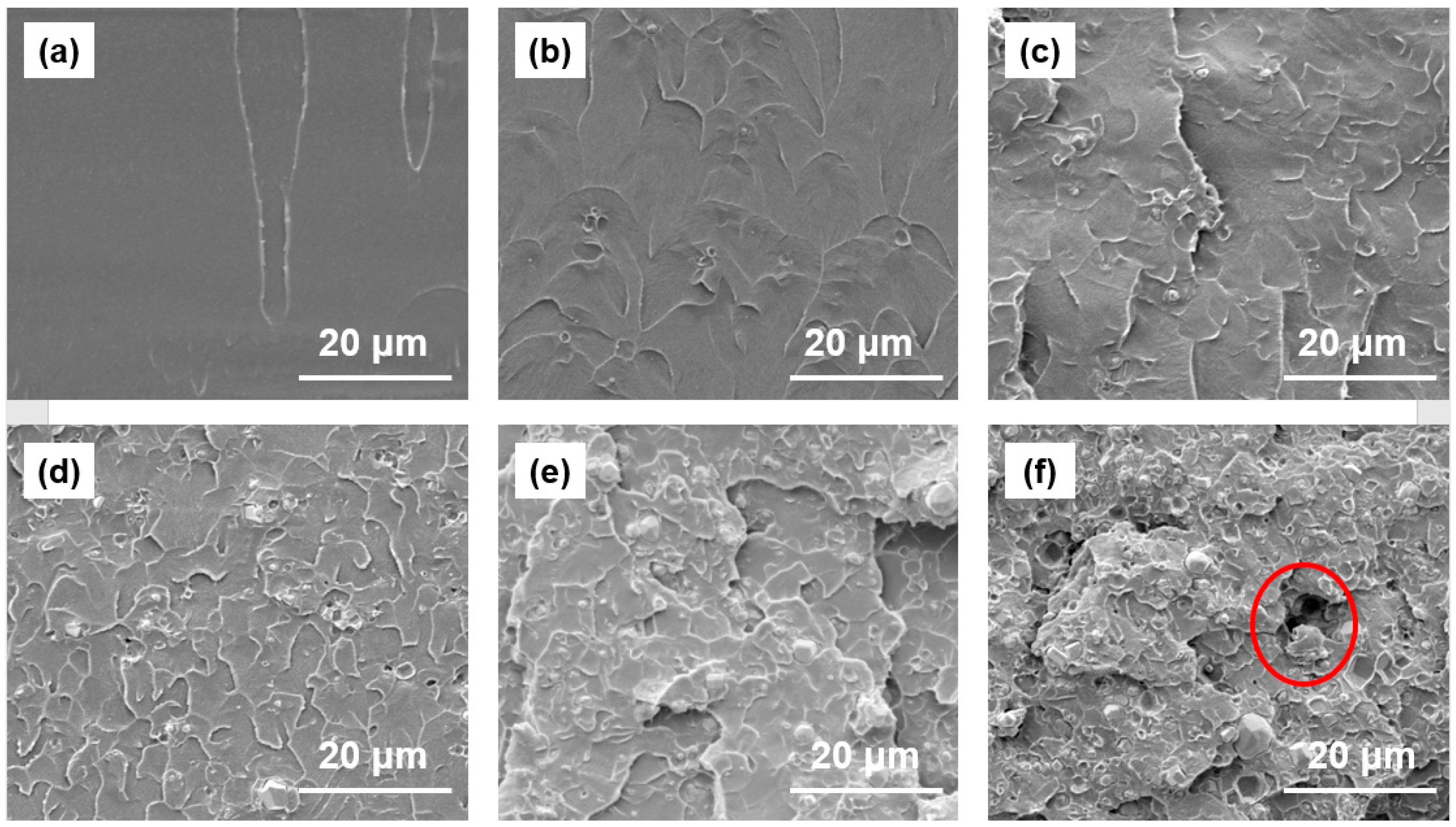
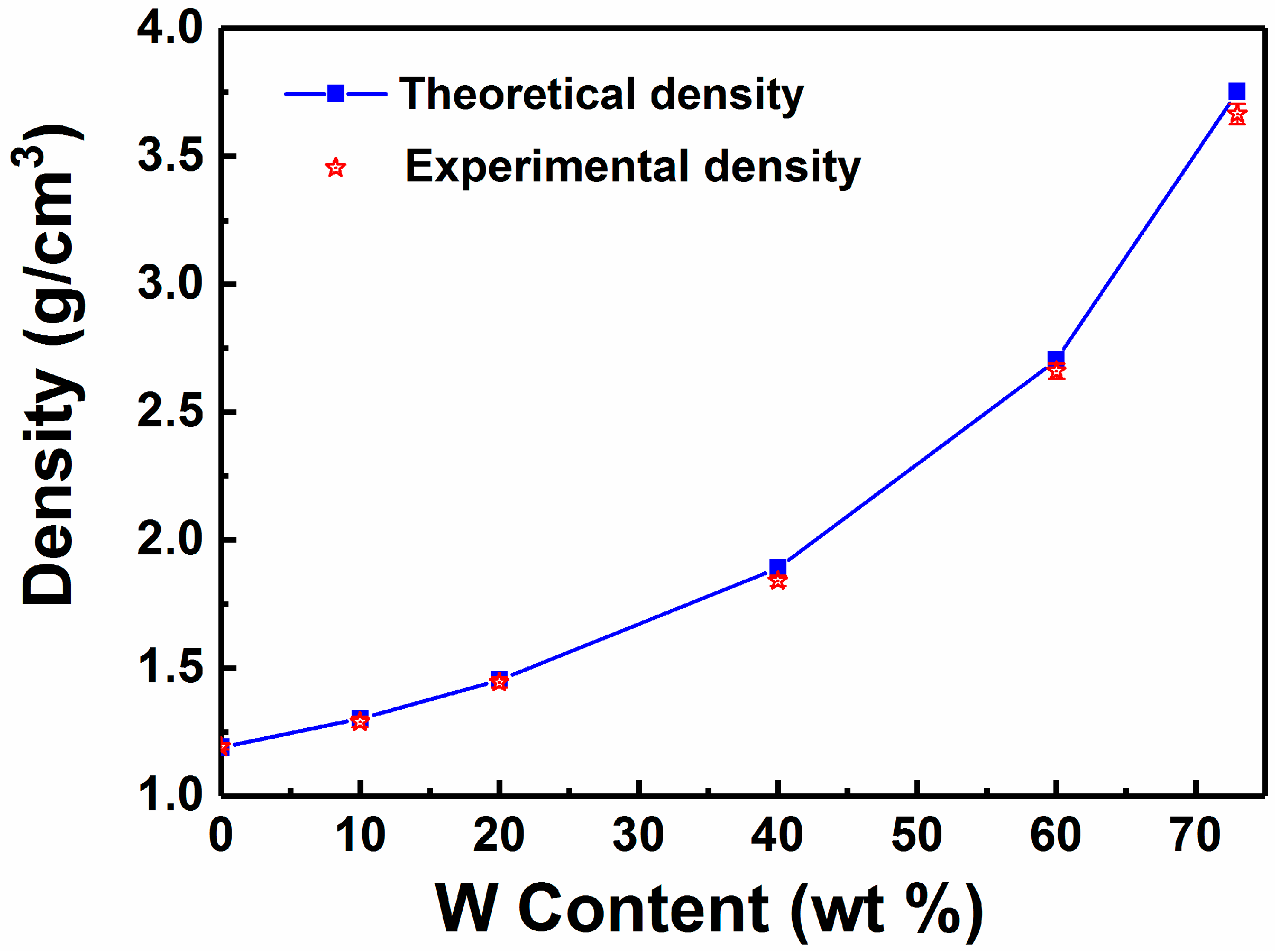
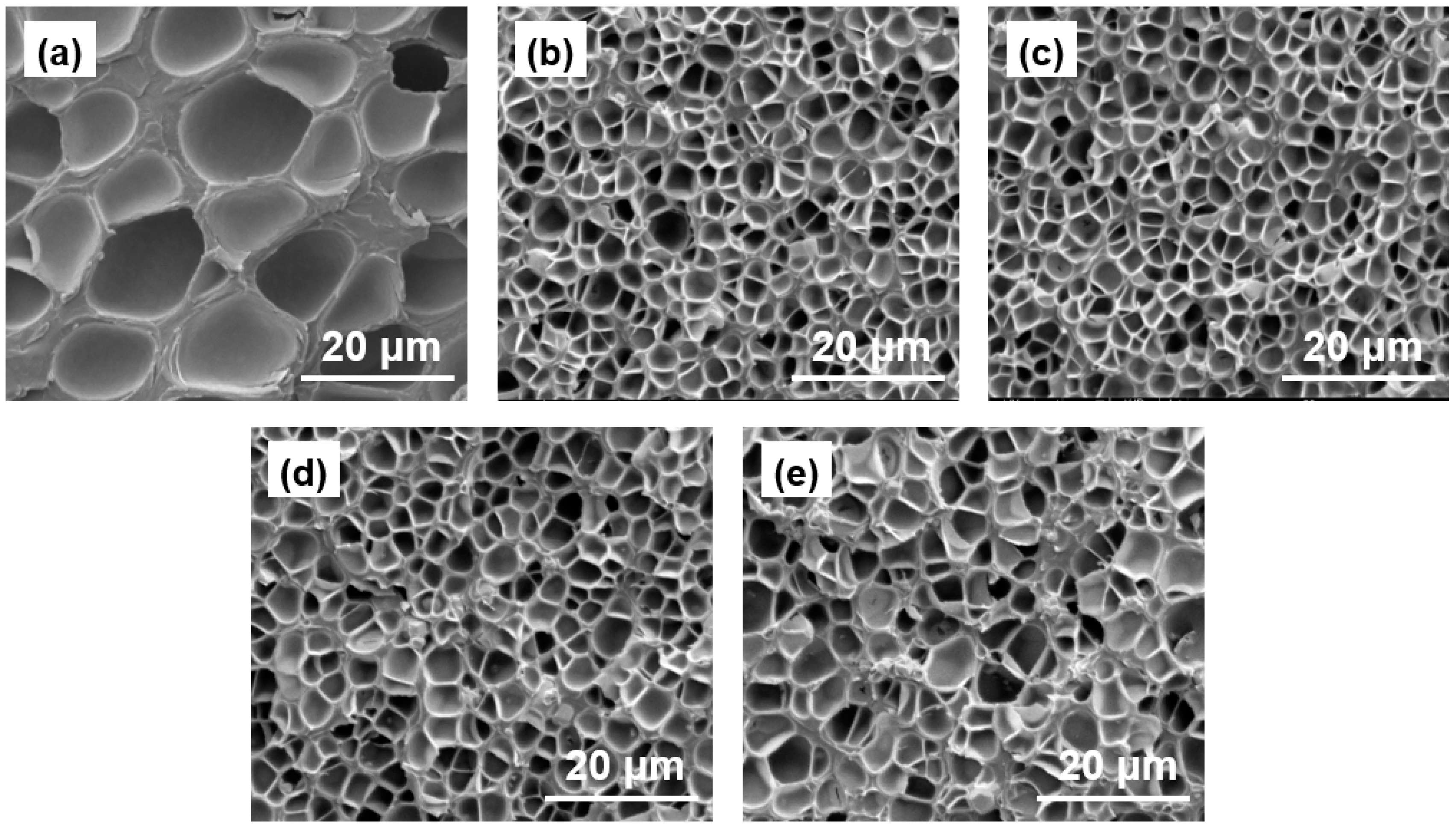
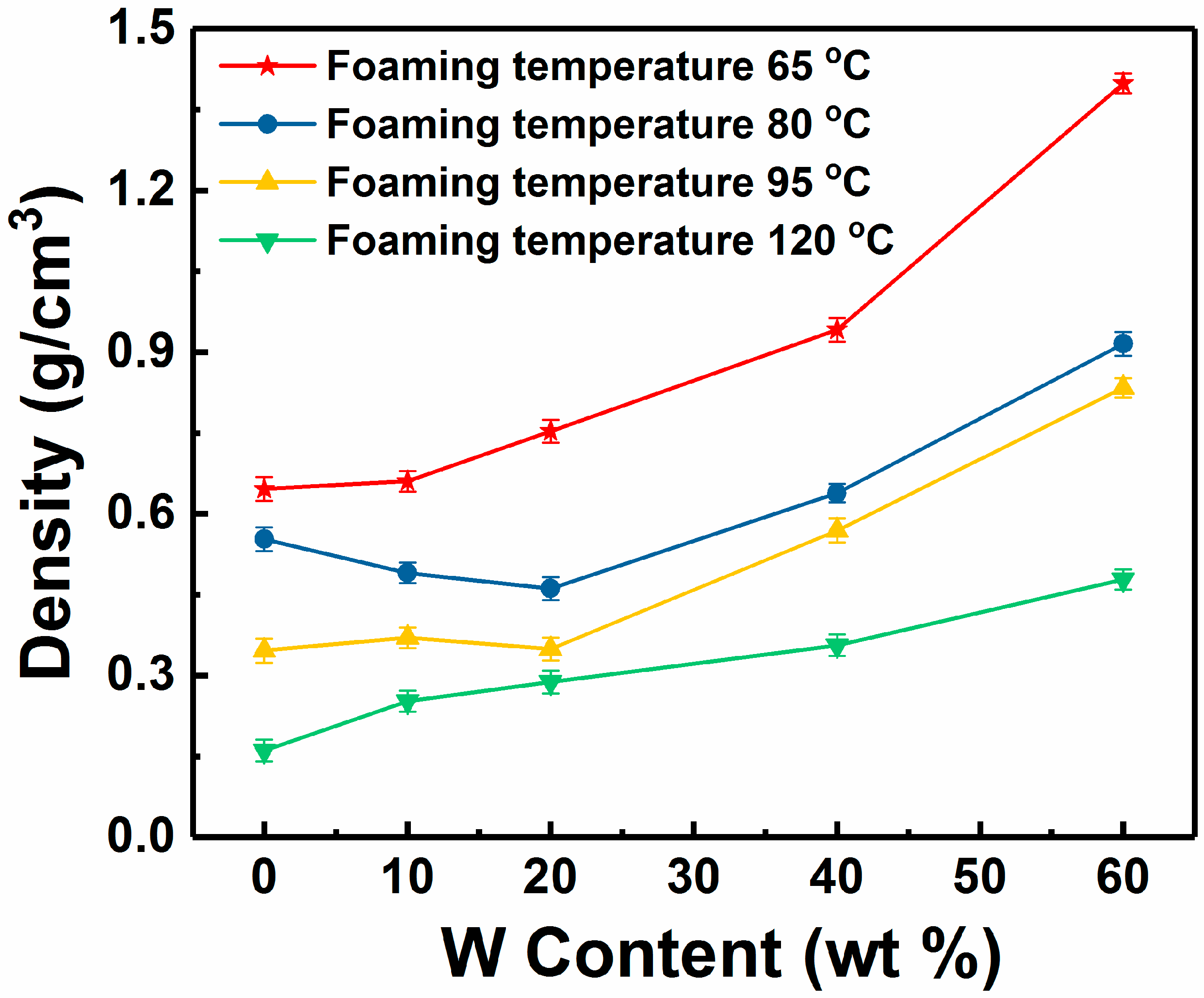
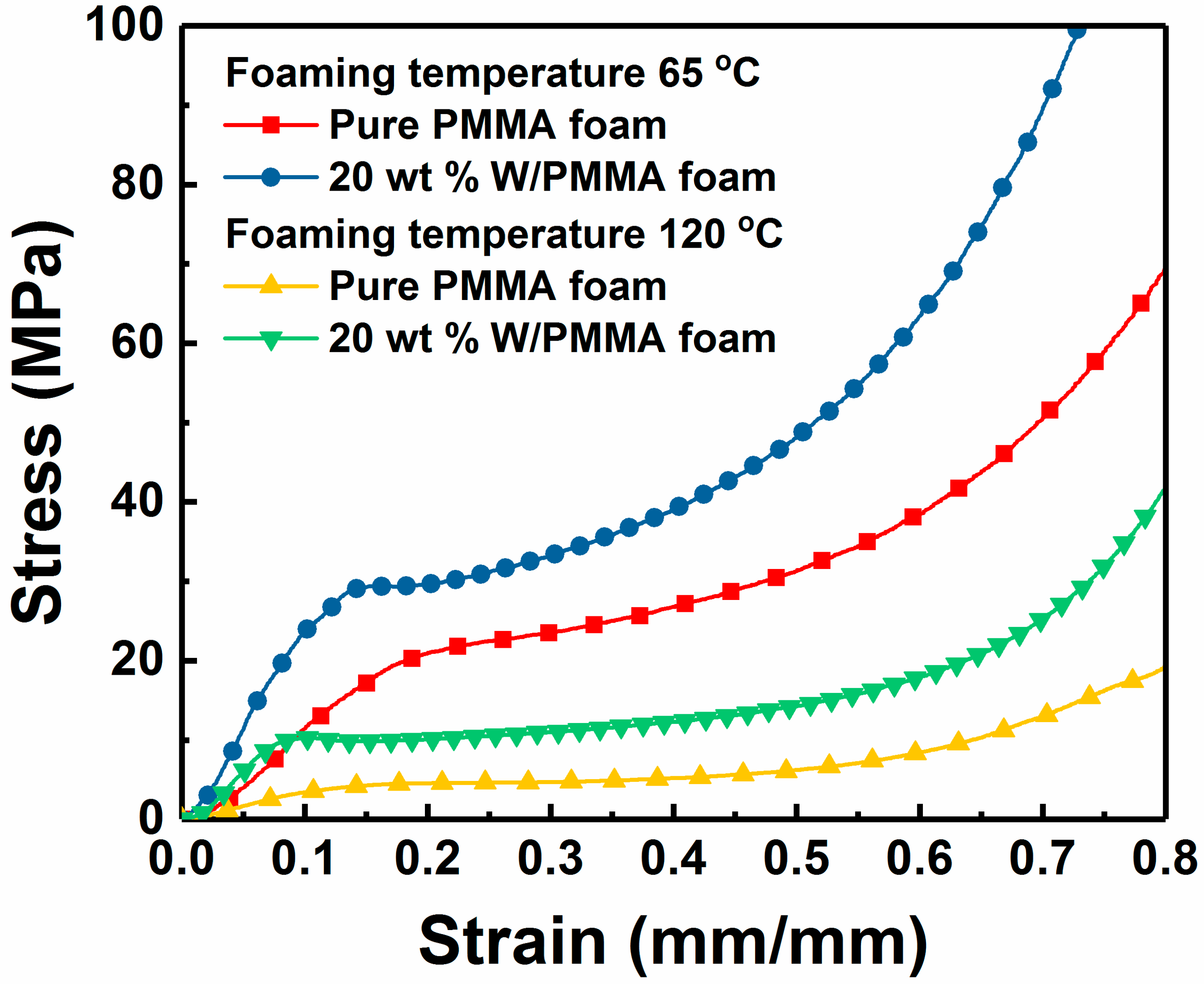
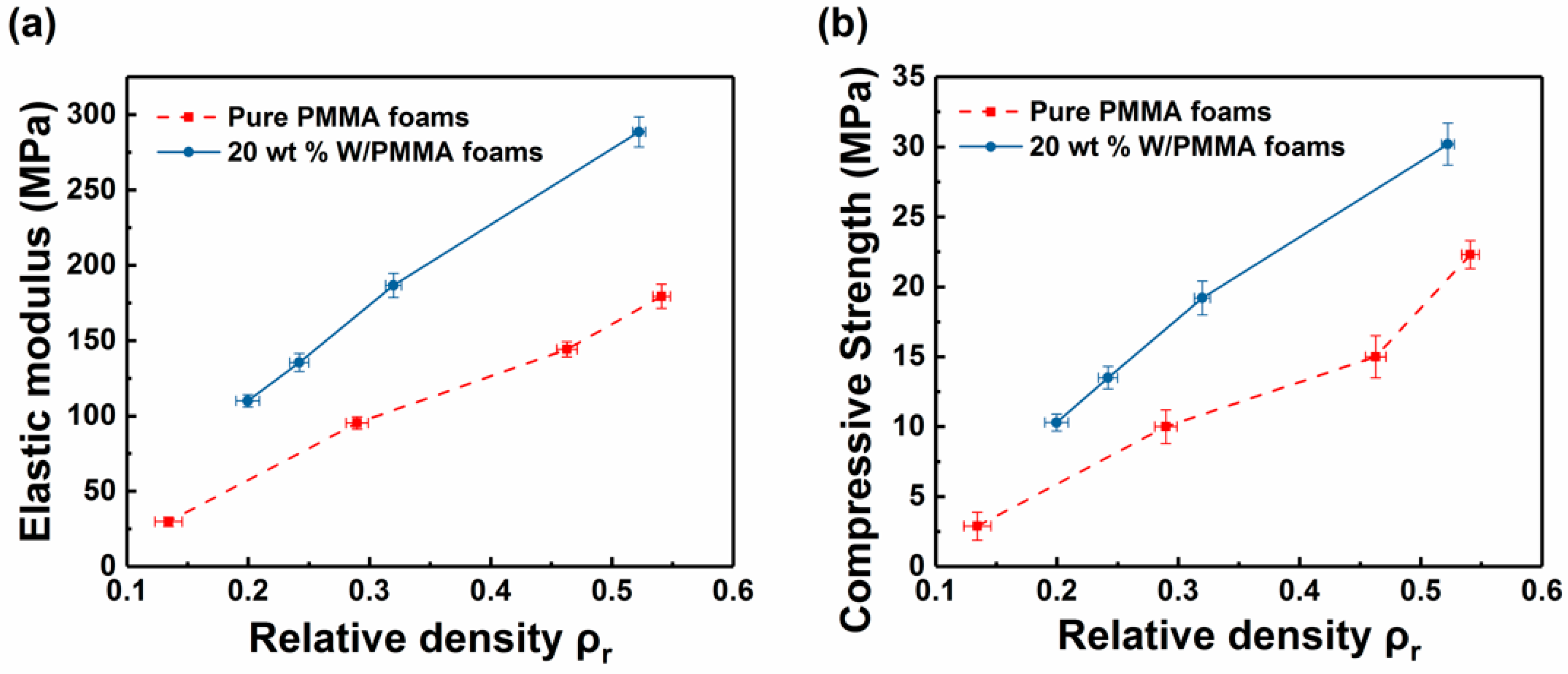
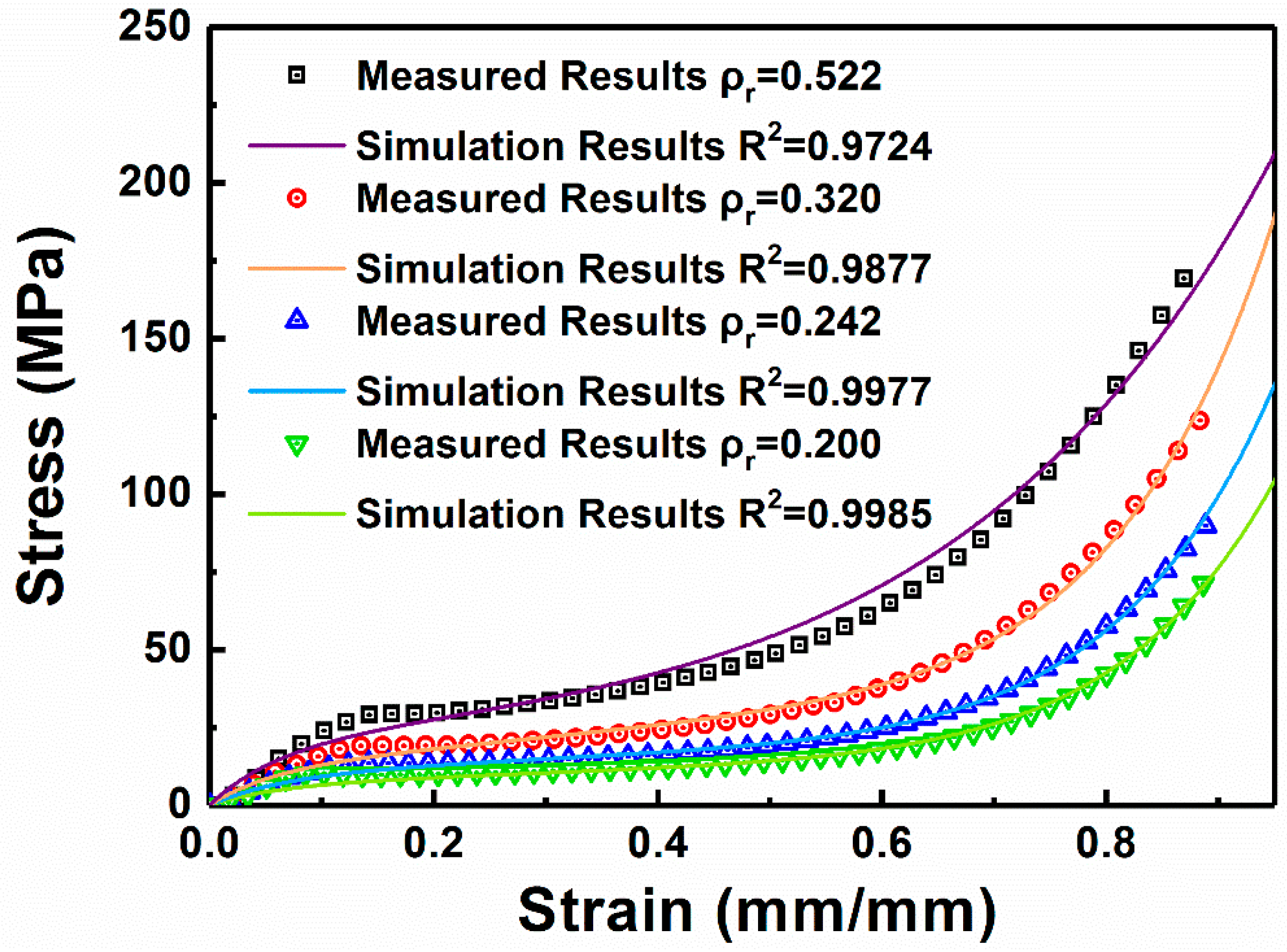
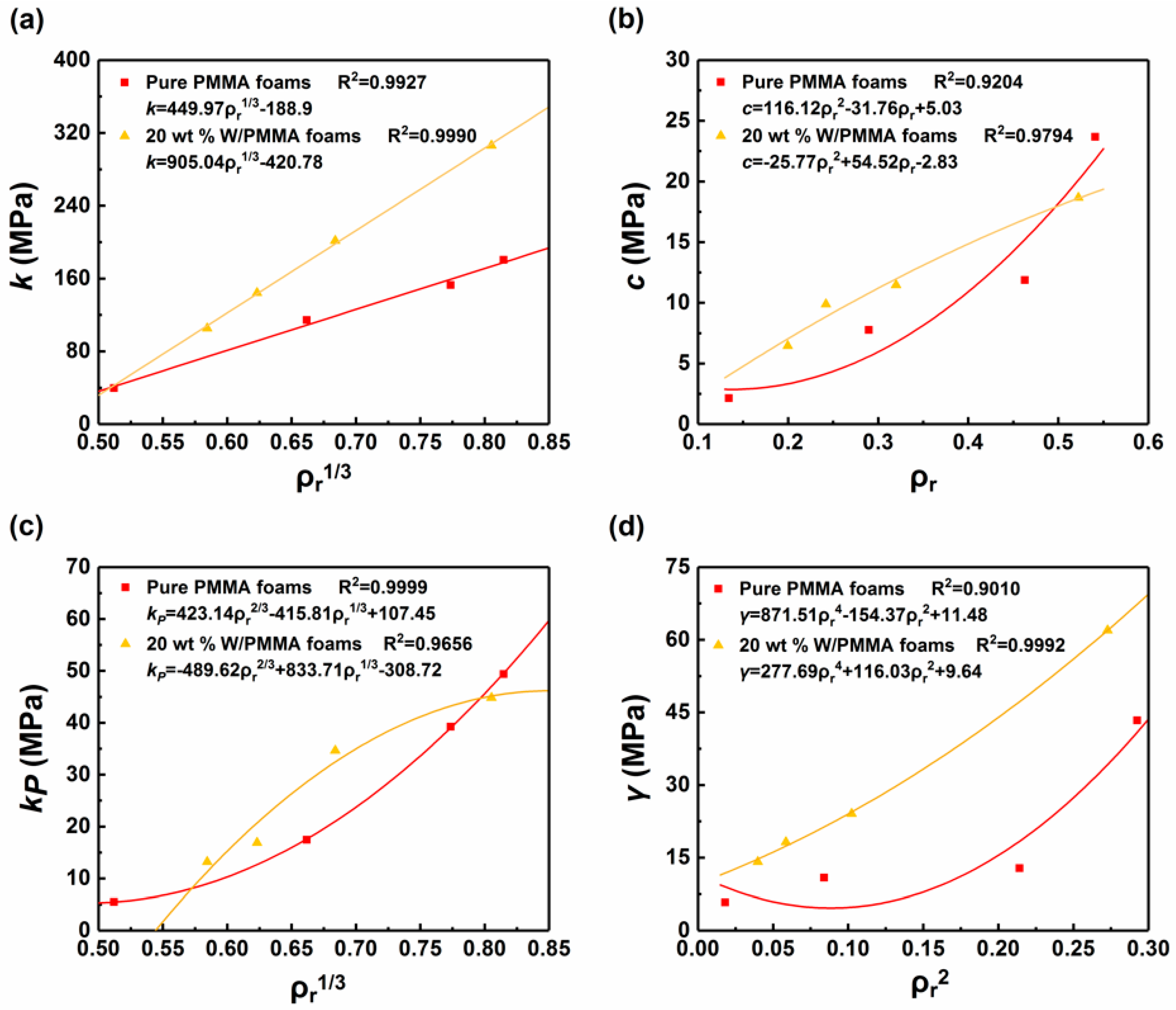
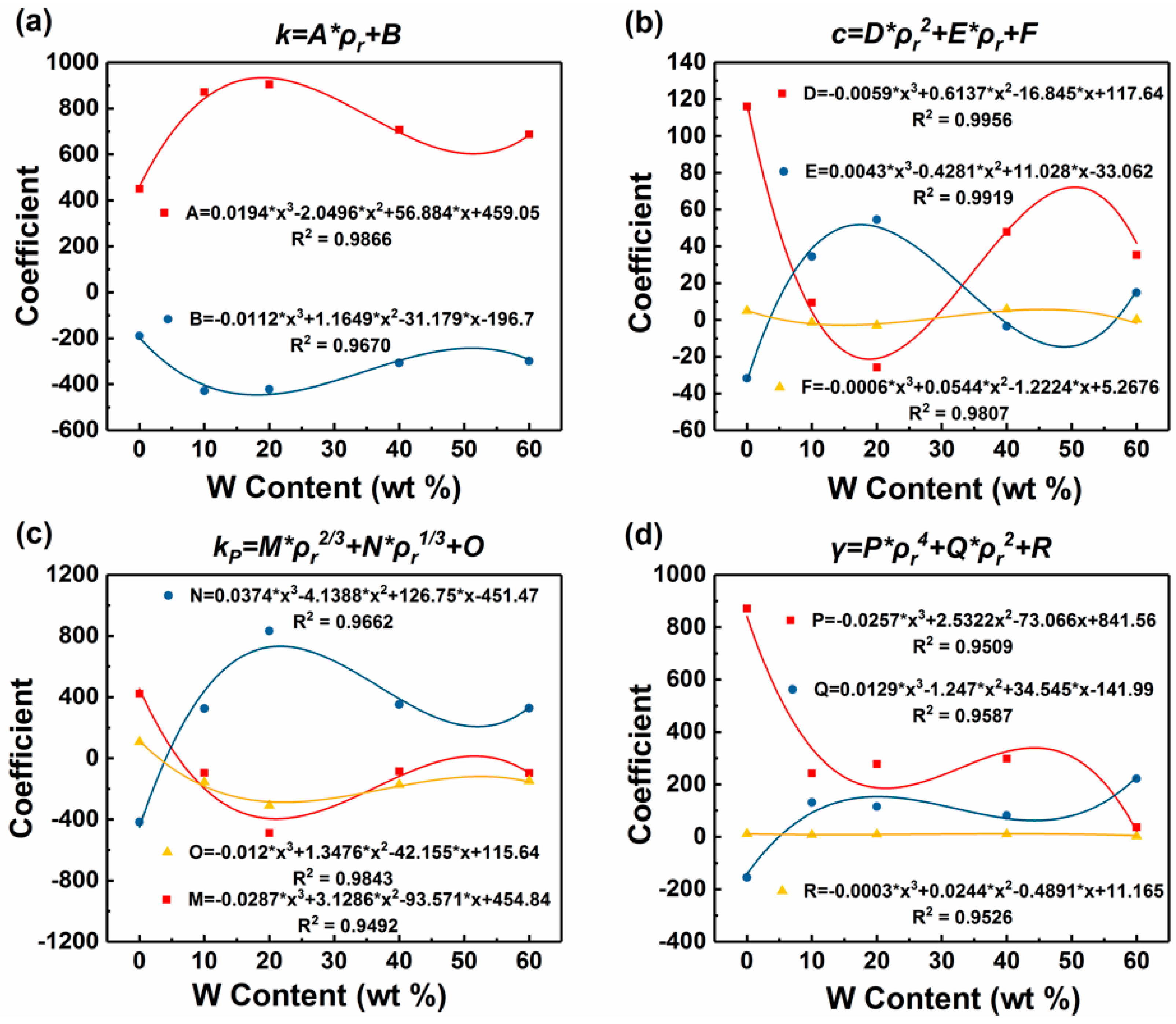

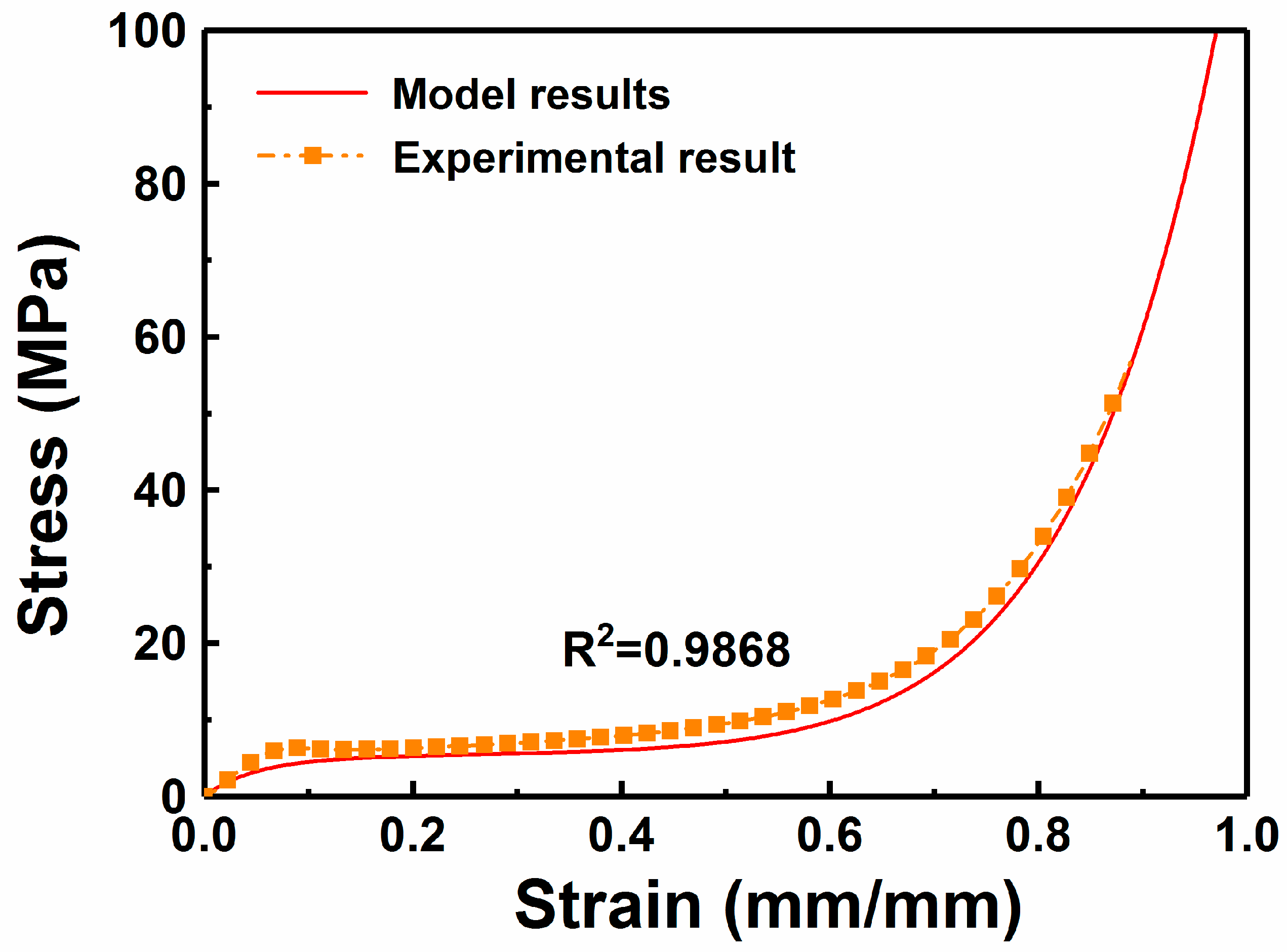
| W Content in the Microcellular Foams | Relative Density (ρr) | k (MPa) | c (MPa) | kp (MPa) | n | γ (MPa) |
|---|---|---|---|---|---|---|
| 0 wt % | 0.134 | 39.6 | 2.15 | 5.5 | 4 | 5.84 |
| 0.290 | 114.3 | 7.77 | 17.4 | 4 | 10.9 | |
| 0.463 | 152.8 | 11.87 | 39.2 | 4 | 12.8 | |
| 0.541 | 180.5 | 23.68 | 49.4 | 2 | 43.4 | |
| 10 wt % | 0.196 | 78.4 | 5.14 | 0.7 | 4 | 10.8 |
| 0.287 | 142.0 | 11.14 | 13.7 | 4 | 24.1 | |
| 0.381 | 211.4 | 11.68 | 31.5 | 4 | 28.9 | |
| 0.513 | 265.9 | 19.23 | 41.7 | 2 | 59.2 | |
| 20 wt % | 0.200 | 105.4 | 6.45 | 13.2 | 4 | 14.2 |
| 0.242 | 144.2 | 9.88 | 16.9 | 4 | 18.2 | |
| 0.320 | 201.7 | 11.47 | 34.6 | 4 | 24.1 | |
| 0.522 | 306.3 | 18.66 | 44.8 | 2 | 62.0 | |
| 40 wt % | 0.194 | 103.6 | 6.96 | 3.7 | 4 | 14.0 |
| 0.310 | 168.3 | 9.93 | 16.1 | 4 | 21.4 | |
| 0.347 | 191.9 | 10.02 | 42.7 | 4 | 24.6 | |
| 0.512 | 259.6 | 16.74 | 52.8 | 2 | 52.5 | |
| 60 wt % | 0.180 | 95.3 | 4.10 | 6.9 | 4 | 11.2 |
| 0.314 | 148.4 | 8.40 | 21.8 | 4 | 20.1 | |
| 0.344 | 192.2 | 9.64 | 43.1 | 4 | 34.3 | |
| 0.526 | 260.0 | 17.92 | 53.3 | 2 | 67.0 |
| W Content in the W/PMMA Microcellular Foams | |||||||||||
|---|---|---|---|---|---|---|---|---|---|---|---|
| A | B | D | E | F | M | N | O | P | Q | R | |
| 0 wt % | 450 | −189 | 116 | −31.8 | 5.03 | 423 | −416 | 107 | 871 | −154 | 11.5 |
| 10 wt % | 871 | −428 | 9.48 | 34.5 | −1.35 | −95.2 | 325 | −157 | 243 | 131 | 7.40 |
| 20 wt % | 905 | −421 | −25.8 | 54.5 | −2.83 | −490 | 834 | −309 | 278 | 116 | 9.64 |
| 40 wt % | 707 | −307 | 47.8 | −3.43 | 5.91 | −85.5 | 351 | −172 | 298 | 81.4 | 10.6 |
| 60 wt % | 687 | −299 | 35.4 | 14.9 | 0.260 | −95.8 | 328 | −149 | 37.2 | 222 | 3.09 |
| Relative Density (ρr) | k (MPa) | c (MPa) | kp (MPa) | n | γ (MPa) |
|---|---|---|---|---|---|
| 0.184 | 100.5 | 4.94 | 2.0 | 4 | 13.3 |
© 2019 by the authors. Licensee MDPI, Basel, Switzerland. This article is an open access article distributed under the terms and conditions of the Creative Commons Attribution (CC BY) license (http://creativecommons.org/licenses/by/4.0/).
Share and Cite
Zhu, Y.; Luo, G.; Zhang, R.; Liu, Q.; Sun, Y.; Zhang, J.; Shen, Q.; Zhang, L. Investigation of the Constitutive Model of W/PMMA Composite Microcellular Foams. Polymers 2019, 11, 1136. https://doi.org/10.3390/polym11071136
Zhu Y, Luo G, Zhang R, Liu Q, Sun Y, Zhang J, Shen Q, Zhang L. Investigation of the Constitutive Model of W/PMMA Composite Microcellular Foams. Polymers. 2019; 11(7):1136. https://doi.org/10.3390/polym11071136
Chicago/Turabian StyleZhu, Yuxuan, Guoqiang Luo, Ruizhi Zhang, Qiwen Liu, Yi Sun, Jian Zhang, Qiang Shen, and Lianmeng Zhang. 2019. "Investigation of the Constitutive Model of W/PMMA Composite Microcellular Foams" Polymers 11, no. 7: 1136. https://doi.org/10.3390/polym11071136
APA StyleZhu, Y., Luo, G., Zhang, R., Liu, Q., Sun, Y., Zhang, J., Shen, Q., & Zhang, L. (2019). Investigation of the Constitutive Model of W/PMMA Composite Microcellular Foams. Polymers, 11(7), 1136. https://doi.org/10.3390/polym11071136





